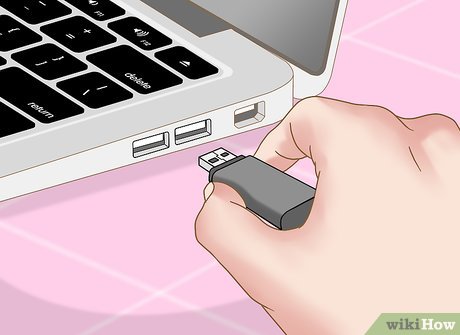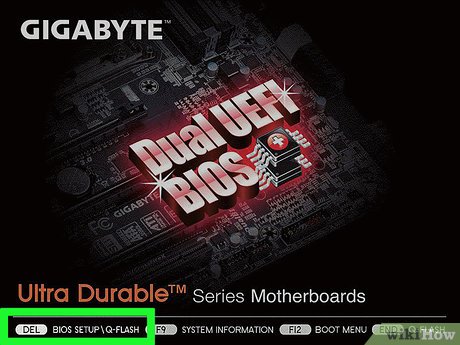How to Boot from USB on Windows 7
Prepare to launch

You need to understand how it works when your computer boots from USB. By default, the computer boots by reading operating system information from the built-in hard drive. You can change this order by telling your computer to prioritize the attached USB item over the built-in hard drive.
Settings for your computer's startup behavior are located in the BIOS menu, which is a pre-boot menu that you can access by pressing a key specific to your computer model at startup.
To boot from USB, the flash drive needs to be set up as a bootable item, and the USB must also have a disk image file (ISO) pre-installed with a similar operating system or service.

Identify your computer's BIOS key. The key you press to access the BIOS will depend on the computer manufacturer and product model. You can look up your computer's BIOS key by entering the computer's model name and manufacturer, followed by the keyword "bios key" into the search engine and then viewing the results. Or if you still have the manual, look for information in it.
Most computers use a function key (e.g. F12) as the BIOS key, but some computers will use the Esc or Del key .

Plug the USB into the computer. The flash drive needs to be plugged into one of the rectangular USB ports on the body.
The USB port is usually located on the side of the laptop body, front or back of the desktop computer case.

Create bootable USB . With a regular USB, you need to use Command Prompt or one of the Windows installation tools to create a bootable drive.

Add the file you want to boot to the USB. Copy the ISO file you want to use for booting by clicking on the file then pressing Ctrl+ C, then opening the flash drive then pressing Ctrl+ Vto paste the contents.
For example, if you are wanting to install or use Ubuntu Linux from a flash drive, paste the Ubuntu ISO file into the USB window.
Skip this step if you created a bootable USB using the Windows 7 or 10 installation tool.

Save and close all open sessions. Before continuing to access the BIOS, you need to save any open sessions and close all programs so that progress is not lost.
Access BIOS

Open Start . Click the multicolored Windows logo in the lower left corner of the screen.

Click Shut down. It's on the right side of the Start menu. The computer will begin to shut down.
You may need to confirm this decision.

Wait for the computer to turn off completely. Once the machine becomes completely silent, you can continue.

Press the computer's power button. The computer will begin to boot.

Immediately, start pressing the BIOS key. You need to proceed quickly as soon as you release the power button, and don't stop until the BIOS screen appears.

Stop pressing the BIOS key when the BIOS page starts loading. The BIOS page usually has a blue screen interface with white text, but your BIOS may be slightly different. At this point, you can change the computer's boot order.
Change boot order

Look for the "Boot Order" section. This option is on the BIOS screen, but you may need to scroll left or right (using the left and right arrow keys respectively) through the tabs at the top of the screen until you find the "Boot Order" section.
You'll probably find this section under the Advanced tab , but there are also many BIOS variations with separate Boot Order tabs.

Open the "Boot Order" menu. If "Boot Order" is a menu item instead of a title, select it using the arrow keys and then press ↵ Enter.

Select the "USB" item. Find and scroll down to the "USB" option in the boot point list.

See key legend. This section is usually located at the bottom right of the screen, sometimes it can also be at the bottom of the screen.

Specifies the key to press to move the selected item up. Usually you will press the + key to move the selected item up, but check the key legend information to be sure.

Move the "USB" option to the top of the list. Press the appropriate key until the "USB" option is at the top of the "Boot Order" list. This will ensure that when starting up, the computer will look for the USB boot option instead of the hard drive as default.
Boot from USB

Save changes and exit BIOS. Press the "Save and Exit" key indicated in the key legend, then press the "Confirm" key when prompted.
For example, you may need to press Esc to save your changes and then press Y to confirm that you want to save and exit.

Restart the computer if necessary. If the computer does not boot from the USB flash drive the first time, the system may have selected the hard drive as the boot point. At this point, you need to restart the computer (with the USB plugged in) before continuing.

Wait for the USB program menu to appear. Once the computer recognizes the USB as a boot point, the program, service, or menu pre-installed on the flash drive will appear.

Follow the instructions on the screen. When the menu appears, you can continue to launch or install the program/service located on the USB.
You should read it
- Windows revolution and breakthrough changes through each version
- Summary of several logout methods on Windows 8 and Windows 10
- Looking back at 27 years of 'evolution' of Windows
- Instructions on how to upgrade from Windows XP to Windows 8
- 4 ways to 'revive' Windows XP on Windows 10
- What is Windows Hello? How does Windows Hello work? How to install Windows Hello
- Instructions for setting up Windows Hello face recognition on Windows 10
- 9 Windows 8.1 errors have not been resolved
May be interested
- How to Fix Boot Loop Problems in Windows
 after starting your windows device, you may sometimes experience an infinite boot loop issue (also known as an 'infinite boot loop' error).
after starting your windows device, you may sometimes experience an infinite boot loop issue (also known as an 'infinite boot loop' error). - Use parallel Windows 7 and Windows 8 on PC
 if you have a pc running windows 7 but aren't sure if you're ready to upgrade to windows 8, a dual-boot system might be a good solution.
if you have a pc running windows 7 but aren't sure if you're ready to upgrade to windows 8, a dual-boot system might be a good solution. - How does Windows 10 start up?
 when you press the pc power button, the windows 10 boot process starts taking place in a certain sequence.
when you press the pc power button, the windows 10 boot process starts taking place in a certain sequence. - DLC Boot - Download DLC Boot here
 dlc boot is a troubleshooting utility that allows users to find and fix problems present in the pc. the application includes various tools that help determine the status of software and hardware installed on a desktop or laptop computer.
dlc boot is a troubleshooting utility that allows users to find and fix problems present in the pc. the application includes various tools that help determine the status of software and hardware installed on a desktop or laptop computer. - What is Boot Sector?
 boot sector is a physical area, or part of a hard drive, that includes information on how to start the boot process to load an operating system.
boot sector is a physical area, or part of a hard drive, that includes information on how to start the boot process to load an operating system. - How to create USB boot versatile, USB rescue by DLC Boot
 to create usb boot, usb rescue we can use dlc boot software with the ability to fix windows errors, data, drive division, computer partition, ...
to create usb boot, usb rescue we can use dlc boot software with the ability to fix windows errors, data, drive division, computer partition, ... - How to check Secure Boot has been enabled on your computer or not?
 on windows 8 and windows 10 versions, microsoft integrates on a feature system called secure boot, and by default this feature has been activated. the secure boot feature supports security on your system but in some cases you will have to disable this feature to run older versions of windows or linux versions.
on windows 8 and windows 10 versions, microsoft integrates on a feature system called secure boot, and by default this feature has been activated. the secure boot feature supports security on your system but in some cases you will have to disable this feature to run older versions of windows or linux versions. - How to fix, fix slow boot computer, Windows 10 boot slowly
 since its launch, windows 10 has affirmed its outstanding advantages. however, after a period of use, you may feel your computer boots slower than before. if you are confident that your computer configuration fully meets the requirements of windows 10, then try to fix the slow boot computer with the following actions
since its launch, windows 10 has affirmed its outstanding advantages. however, after a period of use, you may feel your computer boots slower than before. if you are confident that your computer configuration fully meets the requirements of windows 10, then try to fix the slow boot computer with the following actions - 2 ways to fix the error can not boot into Windows
 2 ways to help you fix the error that cannot boot to win effectively. computer boot up error due to corrupt winload.exe file, please refer to the following article
2 ways to help you fix the error that cannot boot to win effectively. computer boot up error due to corrupt winload.exe file, please refer to the following article - Some tips to speed up Windows 8 boot process
 i can't help but admit that windows 8 has an impressive boot time! however, over time, software applications and a number of system customizations will make the boot time greatly affected, namely windows 8 will take longer to boot.
i can't help but admit that windows 8 has an impressive boot time! however, over time, software applications and a number of system customizations will make the boot time greatly affected, namely windows 8 will take longer to boot.










 How to Restart a Windows Computer Remotely Using the Command Line
How to Restart a Windows Computer Remotely Using the Command Line How to Fix App Download Errors on Microsoft Store
How to Fix App Download Errors on Microsoft Store How to Fix Internet Explorer Windows Not Responding
How to Fix Internet Explorer Windows Not Responding How to Restore Windows 7 Computer to Factory Settings
How to Restore Windows 7 Computer to Factory Settings How to Recover Deleted Browsing History on Windows
How to Recover Deleted Browsing History on Windows How to Uninstall Internet Explorer 11 on Windows 7
How to Uninstall Internet Explorer 11 on Windows 7